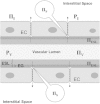Fluid therapy in critical illness
- PMID: 25276346
- PMCID: PMC4178546
- DOI: 10.1186/2046-7648-3-16
Fluid therapy in critical illness
Abstract
Major surgery and critical illnesses such as sepsis and trauma all disturb normal physiological fluid handling. Intravenous fluid therapy for resuscitation and fluid maintenance is a central part of medical care during these conditions, yet the evidence base supporting practice in this area lacks answers to a number of important questions. Recent research developments include a refinement of our knowledge of the endothelial barrier structure and function and a focus on the potential harm that may be associated with intravenous fluid therapy. Here, we briefly describe the contemporary view of fluid physiology and how this may be disrupted by pathological processes. The important themes in critical illness fluid research are discussed, with a particular focus on two emerging ideas: firstly, that individualising fluid treatment to the patient, their underlying disease state and the phase of that illness may be key to improving clinical outcomes using fluid interventions and, secondly, that fluids should be considered to be drugs, with specific indications and contraindications, dose ranges and potential toxicities.
Keywords: Critical illness; Glycocalyx; Goal-directed therapy; Intravenous fluid; Surgery.
Figures

Similar articles
-
Intravenous fluid resuscitation is associated with septic endothelial glycocalyx degradation.Crit Care. 2019 Jul 23;23(1):259. doi: 10.1186/s13054-019-2534-2. Crit Care. 2019. PMID: 31337421 Free PMC article.
-
Promoting and supporting self-management for adults living in the community with physical chronic illness: A systematic review of the effectiveness and meaningfulness of the patient-practitioner encounter.JBI Libr Syst Rev. 2009;7(13):492-582. doi: 10.11124/01938924-200907130-00001. JBI Libr Syst Rev. 2009. PMID: 27819974
-
Personalised fluid resuscitation in the ICU: still a fluid concept?Crit Care. 2017 Dec 28;21(Suppl 3):313. doi: 10.1186/s13054-017-1909-5. Crit Care. 2017. PMID: 29297387 Free PMC article. Review.
-
The impact of the glycocalyx on microcirculatory oxygen distribution in critical illness.Curr Opin Anaesthesiol. 2009 Apr;22(2):155-62. doi: 10.1097/ACO.0b013e328328d1b6. Curr Opin Anaesthesiol. 2009. PMID: 19307890 Review.
-
Emergency nurses' experiences of the implementation of early goal directed fluid resuscitation therapy in the management of sepsis: a qualitative study.Australas Emerg Care. 2021 Mar;24(1):67-72. doi: 10.1016/j.auec.2020.07.002. Epub 2020 Jul 26. Australas Emerg Care. 2021. PMID: 32723674
Cited by
-
Failure to predict amikacin elimination in critically ill patients with cancer based on the estimated glomerular filtration rate: applying PBPK approach in a therapeutic drug monitoring study.Eur J Clin Pharmacol. 2023 Jul;79(7):1003-1012. doi: 10.1007/s00228-023-03516-1. Epub 2023 May 31. Eur J Clin Pharmacol. 2023. PMID: 37256410
-
Context-sensitive fluid therapy in critical illness.J Intensive Care. 2016 Mar 15;4:20. doi: 10.1186/s40560-016-0150-7. eCollection 2016. J Intensive Care. 2016. PMID: 26985394 Free PMC article. Review.
-
Quantitative Investigation into the influence of intravenous fluids on human immune and cancer cell lines.Sci Rep. 2020 Jul 16;10(1):11792. doi: 10.1038/s41598-020-61296-5. Sci Rep. 2020. PMID: 32678120 Free PMC article.
-
Perioperative fluid management: From physiology to improving clinical outcomes.Indian J Anaesth. 2017 Aug;61(8):614-621. doi: 10.4103/ija.IJA_456_17. Indian J Anaesth. 2017. PMID: 28890555 Free PMC article. Review.
-
New Insights into the Fluid Management in Patients with Septic Shock.Medicina (Kaunas). 2023 May 29;59(6):1047. doi: 10.3390/medicina59061047. Medicina (Kaunas). 2023. PMID: 37374251 Free PMC article. Review.
References
-
- Deitch EA. The role of intestinal barrier failure and bacterial translocation in the development of systemic infection and multiple organ failure. Arch Surg Chic Ill 1960. 1990;125:403–404. - PubMed
Publication types
LinkOut - more resources
Full Text Sources
Other Literature Sources

